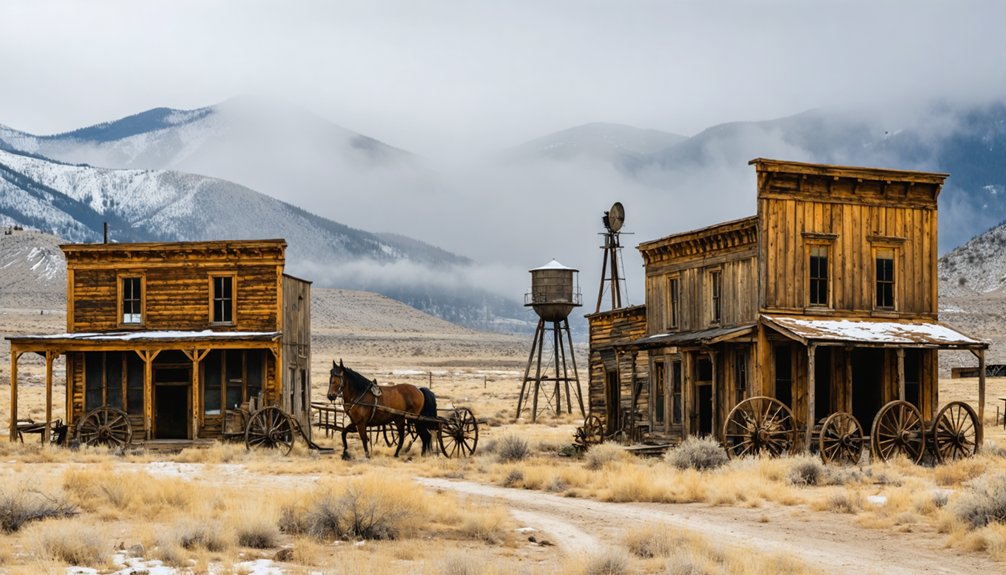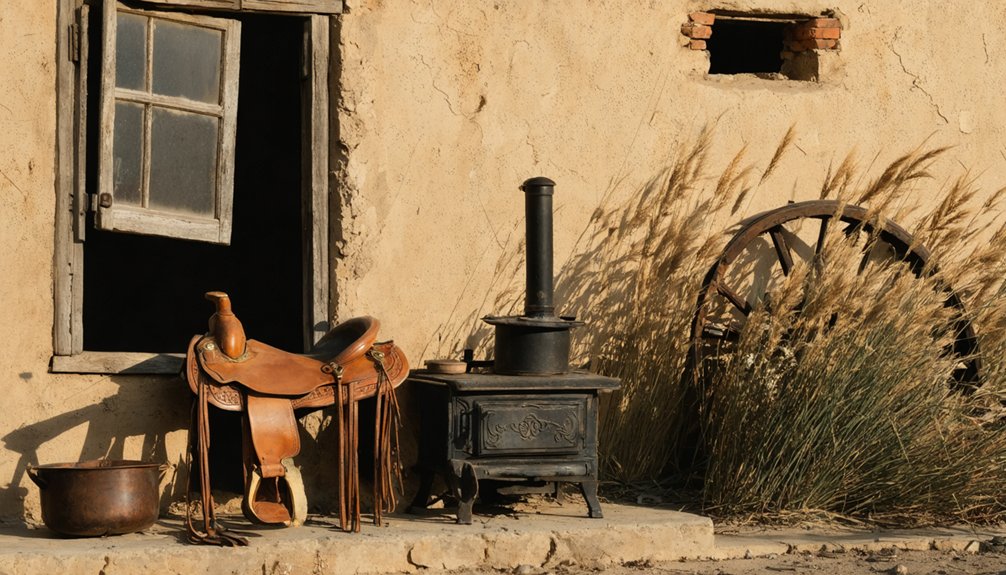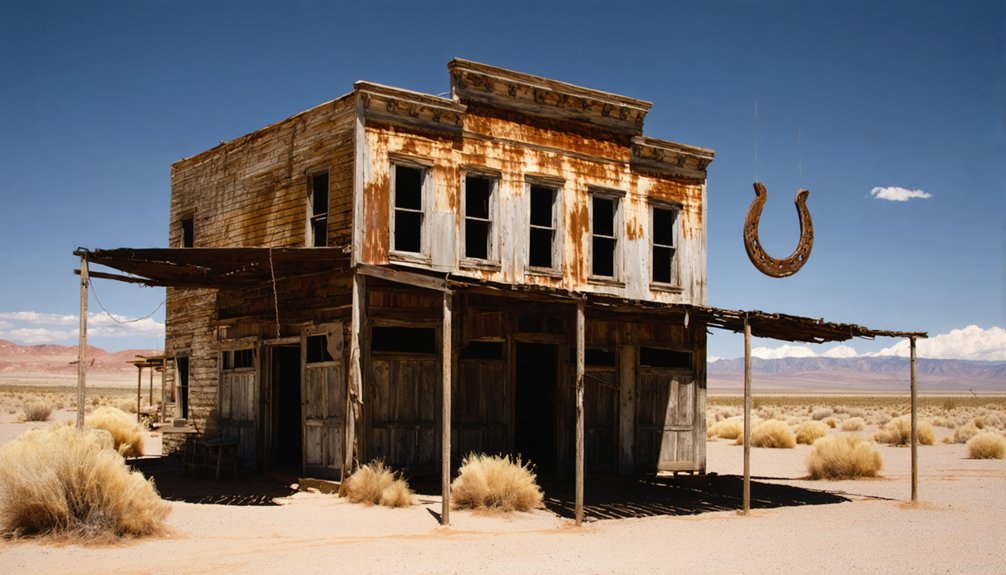You’ll discover America’s most fascinating abandoned frontier sites across the West: Fort Churchill’s adobe military ruins in Nevada, Bodie’s eerily preserved gold rush town in California, Vulture City’s harsh desert mining settlement in Arizona, Harrisburg’s drought-stricken Mormon community in Utah, and Steins’ forgotten railroad stop in New Mexico. Each ghost town reveals unique stories of boom-and-bust cycles, environmental challenges, and the harsh realities that ultimately led to their abandonment.
Key Takeaways
- Fort Churchill, Nevada features preserved adobe ruins of a military outpost that protected settlers and communication routes during the 1860s.
- Bodie, California maintains over 100 original wooden structures in “arrested decay” from its 1877-1882 gold rush peak.
- Vulture City, Arizona was a gold mining settlement that supported 5,000 residents despite harsh desert conditions and indigenous conflicts.
- Harrisburg, Utah was established by Mormon pioneers who implemented irrigation techniques before drought forced abandonment.
- Steins, New Mexico flourished as a railroad stop until post-WWII when water subsidies ended, forcing residents to leave.
Fort Churchill, Nevada: Adobe Ruins of a Military Outpost
Nestled along Nevada’s historic Carson River, Fort Churchill stands as one of America’s most evocative military adobe ruins, its weathered structures silently testifying to the tumultuous period of westward expansion in the 1860s.
Established in response to escalating tensions between settlers and Northern Paiutes, this Union outpost exemplifies frontier military history through its strategic significance.
You’ll find adobe buildings arranged around a parade ground—architectural choices reflecting both local materials and functional necessity. The officer quarters feature 20-inch thick adobe walls designed to withstand harsh desert conditions. The fort protected essential communication routes while serving as a significant Civil War recruiting station. Visitors can explore the park through a visitor center that displays original ordnance, army supplies, and full-scale replicas of Union troops.
Abandoned in 1869 and sold for a mere $750, Fort Churchill gradually deteriorated until Nevada preserved it as a state park in 1957.
Today, these crumbling walls offer you a tangible connection to America’s westward expansion and the complex relationship between military presence and territorial control.
Bodie, California: The Gold Rush Town Frozen in Time
While Fort Churchill reveals the military dimension of frontier expansion, Bodie, California represents the economic engine that drove America’s western settlement: gold fever.
This ghost town reached its zenith between 1877-1882 after a profitable gold vein discovery, transforming from a small mining camp into a thriving community of 7,000-10,000 residents before gradually declining into abandonment.
When you visit this California State Historic Park, you’ll experience:
- Over 100 wooden structures preserved in “arrested decay”
- Interiors still stocked with original frontier goods and furniture
- Remnants of the gold mining operations that yielded $30 million
- A genuine streetscape featuring the bank, church, and some of the town’s 65 saloons
The town takes its name from William S. Bodey who discovered gold in 1859 but tragically died in blizzard while on a supply trip that same year.
Now maintained as both a National Historic Landmark and California’s official Gold Rush Ghost Town, Bodie remains frozen in time. Visitors should be aware that “Bodie” requires disambiguation from others bearing the same name, including several places and people with this distinctive identifier.
Vulture City, Arizona: Mining Settlement in the Harsh Desert
Gold transformed the barren Sonoran Desert into a thriving frontier settlement when Henry Wickenburg, a German immigrant and California gold rush veteran, discovered a rich quartz outcrop in 1863. This discovery birthed Vulture City and Arizona’s most lucrative gold mining operation, eventually yielding 340,000 ounces of gold and attracting 5,000 residents.
The harsh environment necessitated innovative solutions—notably a 15-mile pipeline constructed around 1880 to sustain both mining operations and the community. The settlement was under constant threat from Yavapai and Apache tribes, making daily life particularly dangerous for early residents.
Frontier justice manifested at the infamous Hanging Tree, where 18 men accused of gold theft met their end. The town thrived until 1942, when World War II forced closure. The mine experienced several operational periods, including significant productivity during 1910-1917 before its final shutdown.
Today, the abandoned settlement’s ghost stories abound, with visitors reporting shadow figures and phantom sounds echoing from this once-prosperous desert boomtown.
Harrisburg, Utah: The Mormon Pioneer Town Lost to Drought
Mormon pioneers established Harrisburg in 1859 along Quail Creek in Washington County, Utah, under the leadership of Moses Harris, a seasoned settler who’d previously endured forced relocation from California.
This Mormon community implemented sophisticated irrigation techniques learned from diverse global sources to cultivate the arid landscape, transforming barren desert into farmland through collective effort and innovation. After surviving persecution in Missouri and Illinois, Moses Harris maintained a steadfast spiritual devotion that guided the settlement’s development. Early settlers faced significant challenges when attempting to build a 5-mile irrigation canal along Leeds Creek to support their growing agricultural needs.
The settlement’s challenges included:
- Persistent drought conditions that undermined agricultural viability
- Tense relations with indigenous tribes that disrupted daily operations
- Harsh desert climate requiring constant adaptation of farming methods
- Limited resources that demanded communal sharing and sacrifice
Originally named Harrisville before becoming Harrisburg, the settlement gained formal recognition as an LDS ward by 1877, demonstrating temporary success before environmental pressures ultimately forced its abandonment despite the settlers’ determined resistance against nature’s constraints.
Steins, New Mexico: A Railroad Stop Abandoned When the Trains Stopped
After the Southern Pacific Railroad began blasting operations in Steins Pass in 1878, a modest settlement emerged that would exemplify the transient nature of railroad-dependent communities across the American frontier.
Named for Major Enoch Steen, Steins grew to nearly 1,000 residents by 1920, flourishing as both a fueling stop and source of track ballast. You’d have found a community with saloons, stores, and bordellos—yet no natural water source.
At its peak, Steins thrived despite lacking what every settlement needs most—water flowing from the earth itself.
The railroad’s decision to import water kept Steins alive.
When Southern Pacific ceased water subsidies after World War II, residents abandoned their homes, taking only what they could carry. The 1944 closure of the post office signaled the town’s official demise, with a 1964 fire destroying much of what remained. The town was once the site of a notorious train robbery by the Black Jack Ketchum Gang in 1897. The area had a dangerous reputation due to Apache raids during earlier settlement periods.
Today, this ghost town stands as a stark reminder of railroad history’s impermanence along the frontier.
Frequently Asked Questions
Are These Ghost Towns Accessible During Winter Months?
You’ll find most ghost town tours limited during winter months. Winter accessibility varies greatly—some sites require snowmobiles or snowshoes, while others close completely due to hazardous mountain passes or flash floods.
What Preservation Efforts Protect Artifacts From Looting and Vandalism?
You’ll find artifact preservation implemented through physical barriers, surveillance technology, legal enforcement, community monitoring programs, and looting prevention strategies including randomized patrols and public education about cultural heritage protection laws.
Do Any Descendants of Original Settlers Still Visit Regularly?
Yes, you’ll find descendants visiting through organized family reunions and heritage tours, though their regularity varies with site accessibility, preservation status, and documented ancestral connections to these historic locations.
Can Visitors Stay Overnight in Any of These Locations?
Like ghosts from the past, you can experience overnight stays at select preserved towns. Saint Elmo and Ruby offer historic cabin rentals, while Bodie and Calico maintain designated camping areas with strict overnight accommodations regulations.
What Dangerous Wildlife Might Be Encountered at These Abandoned Settlements?
You’ll potentially encounter predators like bears, wolves, and mountain lions; venomous reptiles including rattlesnakes; and disease vectors such as bats and rodents. Proper wildlife encounter awareness demands thoughtful safety precautions.
References
- https://foxreno.com/news/did-you-know/abandoned-fort-once-guarded-nevada-frontier-did-you-know-history-silver-springs
- https://dot.ca.gov/-/media/dot-media/programs/environmental-analysis/documents/ser/townsites-a11y.pdf
- https://vulturecityghosttown.com/blog/abandoned-america/
- https://en.wikipedia.org/wiki/Wikipedia:WikiProject_Ghost_towns
- https://www.geotab.com/ghost-towns/
- https://www.dhr.virginia.gov/wp-content/uploads/2020/12/The-Historical-Archaeology-of-Virginia-From-Initial-Settlement-to-the-Present.pdf
- https://www.atlasobscura.com/lists/americas-best-preserved-ghost-towns
- https://en.wikipedia.org/wiki/Ghost_town
- https://en.wikipedia.org/wiki/Lists_of_ghost_towns_in_the_United_States
- https://en.wikipedia.org/wiki/American_frontier



